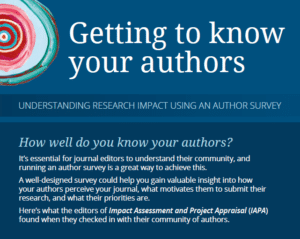We all know the importance of demonstrating research impact. But how can you, as a journal editor, find out what articles published in your journal go on to achieve? Beyond tracking citations or using Altmetric to see online mentions, it can be hard to know what effect an article has had.
In this case study, discover how Impact Assessment and Project Appraisal (IAPA) used an author survey to find out more about author perceptions and priorities, to inform the future development strategy for the journal.
The editors of IAPA surveyed their authors at the end of 2018, asking questions about why they choose IAPA and what happens to their articles after publication. For Thomas Fischer, IAPA’s Editor in Chief, the survey results fall into three key areas:
- Understanding author priorities: why do authors choose IAPA?
- Building a network: connecting authors with their research community
- Making an impact: the real-world effects of publishing in IAPA
Download the infographic below to see the headline results, key findings, and top tips for journal editors. Or, read the results in more detail on the International Association for Impact Assessment (IAIA) website.
We asked Thomas Fischer about his experience of running an author survey – here are his insights:
Why did you decide to run an author survey?
Research impact is becoming increasingly important, particularly in the community which IAPA represents – impact assessment. At a journal meeting with our Managing Editor, I suggested that an author survey would help us to identify what impact research published in IAPA really had, both within academia and beyond.
What are the benefits of running an author survey?
1. Engage with your research community
A survey is a great tool for engaging with your community. Although editors often receive feedback from authors as part of the online submission process, it can be useful to dig deeper with a dedicated author survey, tailored to your journal.
2. Discover how authors perceive the journal
A survey gives you the chance to clarify what matters to your authors, including why they submit their research to you instead of your competitors. Their insights could go on to inform your journal’s content, strategy, development, marketing, and more.
3. Uncover evidence of research impact
An author survey is the perfect place to ask what happens to them, or their article, following publication. Even if you’re tracking the success of individual articles through tools like Altmetric, it’s crucial to check in with your authors directly to stay informed of exciting developments such as new research collaborations, invitations to conferences, or even promotions.
What did you discover about your authors?
IAPA is unique because it attracts both a non-academic readership, and non-academic authors. This is reflected in the survey with over a third of respondents working outside of academia.
Additionally, 36% of respondents said that they chose IAPA because they want to reach a broader readership. A similar percentage suggested that IAPA’s Impact Factor was important to them, so it was essential to receive this three years ago!
What tips do you have for other journal editors?
Reach out to your authors to find out what impact their research is having, both within academia and in the wider world. It could help if you engage with less traditional academic formats. Consider allowing submissions in new styles such as professional practice papers, or letters to the editor. Associate yourself and your journal with a community, and then find ways to engage with them. As the infographic shows, research impact can take many forms. Don’t be afraid to promote your journal in a range of contexts to improve its profile beyond academia.
Learn more about research impact with our guide to developing high-impact content.


